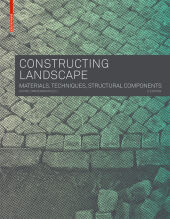 Neuerscheinungen 2015Stand: 2020-02-01 |
Schnellsuche
ISBN/Stichwort/Autor
|
Herderstraße 10
10625 Berlin
Tel.: 030 315 714 16
Fax 030 315 714 14
info@buchspektrum.de |

Astrid Zimmermann
Constructing Landscape
Materials, Techniques, Structural Components
Herausgegeben von Zimmermann, Astrid
3rd ed. 2015. 536 p. 850 b/w and 300 col. ill. 297 mm
Verlag/Jahr: BIRKHÄUSER BERLIN 2015
ISBN: 3-03-560467-3 (3035604673)
Neue ISBN: 978-3-03-560467-2 (9783035604672)
Preis und Lieferzeit: Bitte klicken
Dieses Grundlagenwerk für die technisch-konstruktive Freiraumplanung gliedert sich systematisch in drei Hauptkapitel:
1 Material und Oberflächen bietet eine Übersicht zu den verschiedenen Baustoffen der Landschaftsarchitektur und ihre spezifischen Eigenschaften sowie Erläuterungen zu Oberflächenqualität und ihre Bearbeitungsmöglichkeiten. 2 Konstruktion von Freiraumelementen: das grundlegende Kapitel zu Prinzipien der Statik, Verbindungen tragender Elemente, Gründungen von Bauteilen und Stützbauwerken. 3 Bauelemente und Bauweisen: der umfangreichste Teil zu den Konstruktionsprinzipien aller Bauelemente und Techniken mit detaillierten Zeichnungen.
Zu jedem Kapitel gibt es entsprechende Beispielprojekte mit Fotos und technischen Zeichnungen. Das Buch ist unverzichtbar für die fachgerechte Ausführungsplanung und fundierte Vorbereitung von Ausschreibungen in der Landschaftsarchitektur.
Für die dritte Auflage wurde das Werk durchgesehen, überarbeitet und insbesondere hinsichtlich neuer Richtlinien und Normen aktualisiert.
"Erstmals steht mit dem Handbuch eine gründliche und aktuelle Darstellung landschaftsgestalterischer Techniken zu Verfügung, die dem Laien wie dem Fachmann gleichermaßen nützt." (Bauwelt)
"Bausteine des Wissens sind es, die bis zum richtigen Dübel, zum tragfähigen Träger, zur strapazierfähigen Wiesensaat zusammengestellt sind. Nach dem Band Architektur konstruieren ein weiteres Standardwerk für mehr Bodenhaftung im ach so bildbetonten Architekturbetrieb." (db deutsche bauzeitung)
Constructing Landscape is a systematic introduction to technical and constructional open space planning, with all the relevant topics, from the most common materials and surfaces to the construction of open space elements and the use of plants. For landscape architects and architects it is an indispensable guide to correct and professional execution planning as well as to preparing solid and well-thought-out requests for proposal. Constructing Landscape is divided into two sections, Materials and Surfaces and Building Construction and Building Elements. The first section provides an overview of the various building materials of landscape architecture and their specific characteristics. It also explains the qualities of surfaces and the different approaches to treating them. The second section begins with an introductory chapter explaining the principles of statics, the connections of load-bearing elements, and the various approaches to anchoring building compo-nents and supporting structures. The subsequent chapters use drawings and text to present the constructional principles and techniques associated with the various building elements. Each chapter concludes with a collection of sample projects, illustrated with photographs and technical drawings.
Introduction
Essay
1 Material
1.1 Soil
1.2 Plants
1.3 Lawns and other seeded areas
1.4 Wood
1.5 Natural stone
1.6 Bricks and clinker
1.7 Concrete
1.8 Metal, steel in particular
1.9 Other building materials
2 General principles for loadbearing structures
2.1 Loadbearing structures
2.2 Connecting loadbearing elements
2.3 Foundations and retaining structures
3 Building elements and building methods
3.1 Earth structures and ground relief
3.2 Paths and squares
3.3 Steps and ramps
3.4 Handrails, banisters and fences
3.5 Walls
3.6 Small buildings and pergolas
3.7 Walkway structures and wooden platforms
3.8 Small bridges
3.9 Plantations and planting techniques
3.10 Lawns and other seeded areas
3.11 Drainage plant and systems
3.12 Water features
3.13 Vertical planting
3.14 Roof planting
3.15 Standard and non-standard
Appendix


